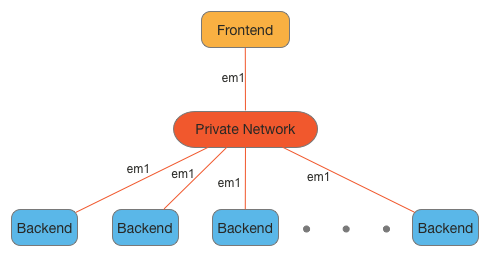Frontend Installation Basics
Stacki requires a single server that will host all the software and services used to build out other servers. We call this server the frontend, and the first step to running Stacki is to build a frontend.
The process is fairly simple and looks similar to a standard Linux build with the addition of a wizard to capture site-specific networking information.
Requirements
A frontend has the following hardware requirements
| Resource | Minimum | Recommended |
|---|---|---|
| System Memory | 8 GB | 16 GB |
| Network Interfaces | 1 | 1 |
| Disk Capacity | 100 GB | 200 GB |
| CD/DVD Device | 1 | 1 |
BIOS boot order
- CD/DVD Device
- Hard Disk
- Not PXE!
In the simplest configuration, Stacki assumes a single network for all servers. Stacki refers to the single network as the private network, and often this will be an isolated network. This default setup in shown below.

The private network cannot have another DHCP server that would answer a DHCP request from a backend server. The frontend provides DHCP services on the private network, and any additional DHCP server would cause conflicts on the network. (Two+ DHCP servers can co-exist if the Stacki frontend answers ONLY for the backend nodes on the shared subnet and the other DHCP server(s) does not.)
New or Existing
The Stacki frontend runs on top of a CentOS/RHEL flavored 7.6 base.
You have three options:
Building on new server
If you don’t have an already existing vanilla CentOS or RedHat 7.6 system, build a new server from bare metal with Stacki and the required CentOS bits (which we call “stackios”).
Follow the Frontend Install - New doc.
You can also install a frontend by:
Building on an existing server
If you wish to install Stacki on top of an existing vanilla CentOS or RedHat 7.6 system, follow the document labeled Frontend Install - Existing.
Building in a VM using Cluster Up
Stacki includes a tool called Cluster Up that can install a frontend in a VirtualBox or KVM VM, in a completely automated fashion. Follow the document labeled Frontend Install - Cluster Up.
This procedure works for any CentOS/RHEL system including Oracle and Scientific Linux.
Edited by: Chris Ladd on Fri Oct 11 14:35:34 2019 -0700
Commit: 35da975